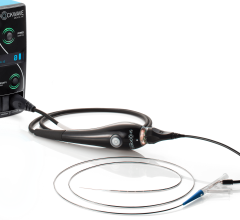The Fysicon QMAPP hemodynamic monitoring system is the newest system to gain FDA clearance. It is about the size of a ream of paper.
Beyond measuring blood flow, pressure, oxygen levels and other vital signs in the cardiac catheterization lab, current hemodynamic monitoring systems are an integral part of clinical reporting. Hemodynamic data from newer systems helps autocompletion of data fields in procedure reports, can automate gathering registry data, and can help interface cath lab patient data with the patient’s electronic medical record (EMR).
In the cath lab, the hemodynamic system is at the core of all procedures, including cardiac procedures, interventional radiology, vascular surgery and electrophysiology (EP). Newer-generation hemodynamic monitoring systems have interfaces to help document all types of procedures. This may include charting, device usage, specific site identification, fractional flow reserve (FFR), sheath exchanges, and automatic timers to record balloon inflation time and pressures applied. The data gathered by the system helps speed workflow by automatically generating reports and auto-fills report fields and billing information. Interfaces also display and record waveforms. Many features of these systems can be customized to each cath lab’s needs.
CVIS-Hemodynamic Integration
Two key requirements for today’s cardiovascular information systems (CVIS) are solid integrations with both enterprise-wide EMR systems and the cath lab’s hemodynamic monitoring system. Both will enable increased efficiency, faster workflows and the ability to meet the need for increased data integration requirements. Tight integration between the CVIS and the hemodynamic system eliminates the need to manually tabulate or re-enter data that is already stored in an electronic format.
With a good CVIS-hemodynamic system interface, diagnostic cath reports can be completed after a procedure in about five minutes. Interventional reports can be completed within roughly 10-15 minutes, with the hemodynamic measures automatically populating some of the report fields. Automatic transfer of hemodynamic data also helps shorten the manual process of transferring this data into registry reporting templates for the National Cardiovascular Data Registry (NCDR) CathPCI database.
Players in the U.S. Market
In September 2017, Fysicon received U.S. Food and Drug Administration (FDA) clearance for its QMAPP Hemodynamic Monitoring System. The QMAPP amplifier is the size of a ream of A4 paper, features all available vital patient monitoring parameters and has up to 32 bipolar intra-cardiac channels for electrophysiology procedures. The system is fanless, which minimizes the risk of cross-contamination and allows use in a hybrid OR environment. The hardware design of QMAPP ensures a high level of usability. The unit is connected via one single cable to the floor base of the X-ray table and with a clamp mounted to the DIN-Rail. The acquired vitals and reporting entries can easily be exchanged with any EMR system using standard protocols like DICOM and HL7.
GE Healthcare offers two hemodynamic systems, Mac-Lab for cardiac cath labs and ComboLab for combined electrophysiology and hemodynamic recording. These systems own a large marketshare in the United States, with installs in about 4,000 interventional labs.
The Mac-Lab is part of GE’s comprehensive cath lab workflow infrastructure, designed to help improve efficiency. By networking remote workstations, the Mac-Lab creates a seamless data management system throughout the cath lab and allows near-real-time case review outside the department. A design utilizing standard protocols enhances the ability to send and receive information from clinical and IT systems.
The ComboLab system combines the full performance of the CardioLab Electrophysiology Recording System and the Mac-Lab Hemodynamic Recording System in a cost-effective package that enables dual use of cardiac cath and EP labs.
Change Healthcare acquired McKesson’s cardiovascular IT division a couple years ago and recently changed the McKesson software product branding to its own. Change Healthcare Cardiology Hemo (formerly known as McKesson Cardiology Hemo) supports patients of all ages using parallel workflows to deliver a modular solution with flexibility. The combination of leading clinical capabilities with the single database CVIS allows simple, efficient workflow.
Change Healthcare Cardiology Holding Area Charting workstations fully integrate with Change Healthcare Cardiology Hemo by sharing the single DB. This allows for single point data-entry, nurse charting and autonumeric vital import from holding area bed side monitors. In addition, a Procedure Tracking Viewer web application is available, providing near real-time information to clinicians about the progress of the different ongoing procedures and labs/beds occupancy, as well as information to patient family.
IBM Watson Health purchased Merge Healthcare a couple years ago. The Merge Hemo system was named the Best in KLAS for the cardiology software category several times in recent years and is now installed in more than 500 cath labs. The system offers providers the ability to access and manage patients’ digital integrated cardiovascular record from a centralized, Web-based system. Merge Hemo automates cath lab processes into an electronic health record to enable efficient workflow. It uses a touchscreen interface, and makes dry erase and patient wait area boards available anywhere. The system’s department overview includes labs and holding/recovery beds. It also offers multi-facility support on a single server. The system also offers shallow data collection menus, the ability to mark items as required or suggested, and a medication dose calculator.
Philips Healthcare’s Xper Flex Cardio system is equipped with advanced clinical decision support tools to help evaluate a patient’s overall cardio performance. It displays and analyzes invasive blood pressure, surface electrocardiogram (ECG), respiration and other vital signs. The Xper Flex offers several advantages over previous systems, including traditional 12-lead interpretation of the resting ECG in addition to 16-lead analysis, enabling clinicians the freedom to choose which approach is most appropriate for each situation. The additional right chest and posterior leads used in 16-lead ECGs can provide information that may not be apparent on traditional 12-lead ECGs.
Siemens Healthineers offers two hemodynamic systems, the Sensis Vibe and Axiom Sensis. Both offer workflow efficiencies for hemodynamic or EP monitoring in the same system. The small size of the systems also reduces the footprint in the lab. They offer multi-vendor integrated fractional flow reserve (FFR) with report inclusion and auto systolic area index calculations.
The Vibe, the newest system introduced in 2016, helps streamline documentation and reporting by using intuitive operation and simplified data entry. It also has seamless integration with Siemens’ Artis family of angiography systems. Unique features of the Vibe include FlashDoc. The system’s redesigned approach to procedure data documentation targets optimal ease of use and includes three core components that are embedded in a new, intuitive user interface. There also is a case log component, which enables the physician to follow the entire procedure at a glance.
Read the 2017 article "Newer Hemodynamic Monitoring Systems Address Need for Integration."
Watch a video from ACC.16 explaining trends in technology and new hemodynamic systems
Comparison of Hemodynamic Systems
This article served as an introduction for a hemodynamic systems comparison chart, which can be accessed on the DAIC website at www.dicardiology.com/content/hemodynamic-monitoring-systems. This page requires registration, which is free and only takes a minute to complete. The chart includes technical specifications for all the major cath lab hemodynamic systems on the U.S. market.
Chart participants include:
GE Healthcare
www.gehealthcare.com
Change Healthcare (formerly McKesson)
www.changehealthcare.com
Fysicon
www.fysicon.com
IBM Watson (formerly Merge Healthcare)
www.ibm.com/watson/health/
Philips Healthcare
www.healthcare.philips.com
Siemens Healthineers
usa.healthcare.siemens.com


 March 17, 2025
March 17, 2025 








